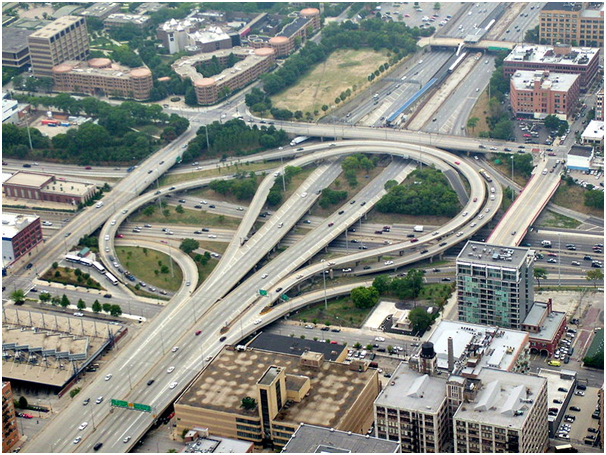China in Modi mode - 2: Economic Compulsion to Resolve Border Dispute
One of the many flyovers in China
BEIJING: For the first time after the Manmohan Singh-Wen Jiabao summit in 2008 seeded the ground for a thriving economic relationship, China is harping on the need to settle the boundary dispute as a basis for increasing trust and stabilising relations. There may be many reasons behind Beijing’s current push for the dispute to be taken up during Prime Minister Narendra Modi’s visit next month. Some of these underlying factors came to the fore when officials, diplomats, experts and think-tank strategists briefed Indian journalists last week in Beijing and Xi’an.
The primary rationale appears to be economic, and it was best articulated by Mr Hu Shisheng, Director in the China Institutes of Contemporary International Relations and Mr Liu Jinsong, Deputy Director-Genral in the foreign ministry’s Department of International Economic Affairs.
Hu said that China needs stability -- in its frontier areas, neighbourhood and bilateral relations -- for economic development. China’s growth has reached a plateau and India’s GDP is growing at a higher rate than that of China. This is cause for serious concern.
Although China bucked the global financial crisis of 2008, Hu said that its economy is slowing down. The slowdown was because the prevalent economic model could no longer deliver the growth rate that China had achieved. China’s economy required a new cycle, a paradigm shift. The new cycle could not go forward without new partnerships, and an India-China partnership was important for generating new impulses for development – of infrastructure, industry, energy hubs and assets – in the region as a whole.
Liu spoke along the same lines of a China-India strategy for a larger international role. He emphasised the need for India to play a bigger role in global governance and developing new frameworks for cooperation. “Whether we are talking about Silk Belt Road or Maritime Route, cooperation with India in the areas of infrastructure, energy and poverty alleviation is of critical importance”, he said.
China has the sovereign funds and investible surplus to pump in to its neighbourhood and it needs to do so for revival of its own growth rate. Without new markets, projects, products, industries and consumers in South Asia, especially India, the Chinese economy cannot advance. And, a higher growth rate is important for China’s rise.
Hu sees economic cooperation and India-China partnership as a prerequisite for acceptance of China’s rise in the region. “China must do whatever is required to become more acceptable in India”, he said.
More than once in the course of these interactions it was recalled that bilateral visits, particularly of Premier Li Keqiang and President Xi, have been marred by Chinese incursions across the border. One way to ensure that this doesn’t happen is to solve the boundary problem, said Hu. “That requires a higher level of political comfort and trust between the two countries”.
Increasing political trust, which has been eroded by recurrent border incursions, is seen by officials and experts as being essential to “stabilising” India-China relations; and, unless headway is made on the boundary issue, the incursions and consequent lack of trust, are bound to keep rocking the relationship.
Yang Wenchang, the President of the Chinese People's Institute of Foreign Affairs, expects that Modi and Xi would at least make a beginning in this direction “even if they cannot solve the boundary problem”.
Huang Xilian, Deputy Director-General in the foreign ministry’s Department of Asian Affairs, underlined “a mutually acceptable solution to the boundary problem” as an important area of “focus for Modi’s visit”. Huang pointedly said that "We (India and China) both have strong leadership (in Modi and Xi)… to provide strong guidance including on negotiation of the boundary question. Both have agreed to strive for a fair and mutually acceptable solution."
Yang recalled that when President Xi visited India in September 2014 he and Modi had “decided” to resolve the long-standing border dispute according to the Agreement on the Political Parameters and Guiding Principles for the Settlement of the Boundary Question signed by the two governments in April 2005.
It is no secret that Prime Minister Jawaharlal Nehru had, in 1960, rebuffed Chinese Premier Zhou En-lai when he mooted a settlement on the basis of status quo. Yang Wenchang recalled that, similarly, Rajiv Gandhi too, during his visit in 1988, had failed to seize the opening for a solution when it was proposed by “Paramount Leader” Deng Xiaoping.
The subtext may well be that Modi has the chance of “undoing” another “Nehruvian legacy” and making a breakthrough to what the Nehru-Gandhi family had never attempted.
Modi’s visit to China -- especially in the context of Xi’s trip to Islamabad where he inked deals for investments worth $ 46 billion – would be replete with challenges and opportunities. How Modi turns the situation to India’s advantage would be keenly watched at home and in several capitals, particularly Washington, Moscow, Tokyo, Islamabad and Colombo.
(CONCLUDED) --
(The author, an independent political and foreign affairs commentator, was invited to China by its Ministry of Foreign Affairs for briefings ahead of PM Modi’s visit next month.)




